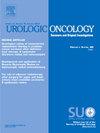Pattern and risk factors of local recurrence and intravesical recurrence after segmental ureterectomy for upper tract urothelial carcinoma
IF 2.3
3区 医学
Q3 ONCOLOGY
Urologic Oncology-seminars and Original Investigations
Pub Date : 2025-05-01
DOI:10.1016/j.urolonc.2025.03.008
引用次数: 0
Abstract
Objective
To investigate the pattern and risk factors of local recurrence and intravesical recurrence of ureteral upper tract urothelial carcinoma (UTUC) following segmental ureterectomy (SU).
Methods
From February 2012 to August 2021, a retrospective analysis was conducted on patients following SU. Univariate and multivariate Cox regression analysis were used to evaluate the risk factors. Kaplan–Meier curves were employed to illustrate survival outcomes.
Results
Among 88 patients, 50 (57%) were male, with a median age of 71 (IQR: 62–77) years. The procedures of ureteral reconstruction included ureteral reimplantation in 77 (88%) cases, ureteroureteral anastomosis in 9 (10 %) cases, Boari flap ureteroplasty with psoas hitch in 1 (1%) case, and cutaneous ureterostomy in 1 (1%) case. The median follow-up time was 44.5 months. The 3-year rate of local recurrence, lymph node metastasis, ipsilateral upper urinary tract recurrence and intravesical recurrence was 31.6%, 19.0%, 22.2% and 35.7%, respectively. G3 (HR = 3.355, 95% CI 1.375–8.184, P = 0.008), and lymphatic vascular infiltration (HR = 3.127, 95% CI 1.043–9.373, P = 0.042) were independent risk factors for local recurrence. G3 (HR = 3.782, 95% CI 1.036–13.812, P = 0.044) was an independent risk factor for lymph node metastasis. Sarcomatoid differentiation (HR = 3.943, 95% CI 1.087–14.308, P = 0.037) was an independent risk factor for ipsilateral upper urinary tract recurrence. Previous or concurrent bladder cancer (HR = 3.280, 95% CI 1.667–6.453, P = 0.001) and sarcomatoid differentiation (HR = 4.442, 95% CI 1.317–14.989, P = 0.016) were independent risk factor for intravesical recurrence. The most common regions for bladder recurrence were posterior wall (21%), same lateral wall (16%) and trigon (16%).
Conclusion
SU is a feasible treatment for selected UTUC patients, yet it is associated with a considerable risk of local and intravesical recurrence. Careful monitoring and active adjuvant therapy are essential to minimize the recurrence rate for patients with risk factors.
输尿管节段切除术后尿路上皮癌局部复发及膀胱内复发的模式及危险因素。
目的研究节段性输尿管切除术(SU)后输尿管上段尿路上皮癌(UTUC)局部复发和膀胱内复发的模式和风险因素:方法: 2012年2月至2021年8月,对接受节段性尿道切除术(SU)的患者进行了回顾性分析。采用单变量和多变量 Cox 回归分析评估风险因素。结果:88名患者中,50名(57%)为男性,中位年龄为71岁(IQR:62-77)。输尿管重建手术包括输尿管再植术77例(88%)、输尿管输尿管吻合术9例(10%)、Boari瓣输尿管成形术加腰肌搭桥术1例(1%)和皮肤输尿管造口术1例(1%)。中位随访时间为 44.5 个月。3年的局部复发率、淋巴结转移率、同侧上尿路复发率和膀胱内复发率分别为31.6%、19.0%、22.2%和35.7%。G3(HR = 3.355,95% CI 1.375-8.184,P = 0.008)和淋巴管浸润(HR = 3.127,95% CI 1.043-9.373,P = 0.042)是局部复发的独立危险因素。G3(HR = 3.782,95% CI 1.036-13.812,P = 0.044)是淋巴结转移的独立危险因素。肉瘤样分化(HR = 3.943,95% CI 1.087-14.308,P = 0.037)是同侧上尿路复发的独立危险因素。曾患或并发膀胱癌(HR = 3.280,95% CI 1.667-6.453,P = 0.001)和肉瘤样分化(HR = 4.442,95% CI 1.317-14.989,P = 0.016)是膀胱内复发的独立危险因素。最常见的膀胱复发区域是后壁(21%)、同侧壁(16%)和三叉神经(16%):结论:对于选定的UTUC患者来说,膀胱切除术是一种可行的治疗方法,但它也存在相当大的局部和膀胱内复发风险。对于有风险因素的患者,仔细监测和积极辅助治疗对于最大限度地降低复发率至关重要。
本文章由计算机程序翻译,如有差异,请以英文原文为准。
求助全文
约1分钟内获得全文
求助全文
来源期刊
CiteScore
4.80
自引率
3.70%
发文量
297
审稿时长
7.6 weeks
期刊介绍:
Urologic Oncology: Seminars and Original Investigations is the official journal of the Society of Urologic Oncology. The journal publishes practical, timely, and relevant clinical and basic science research articles which address any aspect of urologic oncology. Each issue comprises original research, news and topics, survey articles providing short commentaries on other important articles in the urologic oncology literature, and reviews including an in-depth Seminar examining a specific clinical dilemma. The journal periodically publishes supplement issues devoted to areas of current interest to the urologic oncology community. Articles published are of interest to researchers and the clinicians involved in the practice of urologic oncology including urologists, oncologists, and radiologists.

 求助内容:
求助内容: 应助结果提醒方式:
应助结果提醒方式:


